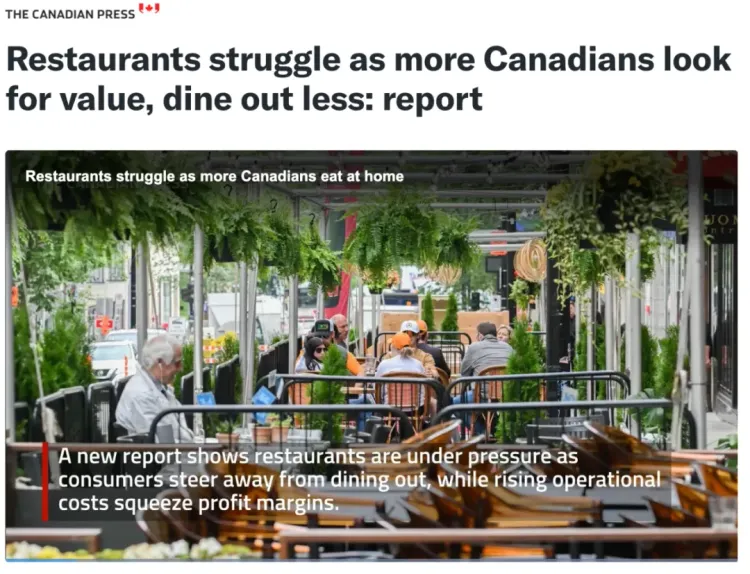Zack, a Canadian soldier in his 40s, turned limited savings...
Read MoreCost-of-Living Surge Forces 75% of Canadians to Dine Out Less — Restaurants Feeling the Heat

Canada’s restaurant industry is under mounting strain. A new report from Restaurants Canada indicates that three out of four Canadians (75%) are dining out less frequently due to rising living costs — a figure that jumps to 81% among those aged 18 to 34.
Kelly Higginson, the association’s CEO, cautions that this shift poses serious challenges. Younger diners, in particular, place greater emphasis on price, value, and convenience.
Key Figures & Trends
Per capita, Canadians currently spend CA$1,035 at full-service restaurants and CA$1,135 at quick-service eateries. Pre-pandemic, these numbers were CA$1,165 and CA$1,150, respectively.
As of June 2025, about 41% of restaurants are operating at a loss or just breaking even.
Operating costs — covering food, labor, insurance, utilities — have seen double-digit increases, while alcohol sales, a high-margin component, are also declining.
Interestingly, quick-service lunch traffic rose 7.6% in early 2025, surpassing pre-pandemic levels, highlighting a shift toward value dining during midday.
Structural Pressures & Opportunities
Inflation & Counter-Tariff Impact
Since March 2025, food inflation has outpaced the Consumer Price Index by roughly 1.4%, in part due to counter-tariffs on essential food imports.Takeout & Delivery Dilemma
With dine-in decreasing, restaurants increasingly depend on delivery. However, third-party commission (15%–30%) and restricted alcohol delivery cut deeply into margins.Shifting Consumer Behavior
Solo dining is on the rise: reservations for one are up ~30%.Retail Insider
Breakfast and lunch are gaining share as consumers shift away from more expensive dinner options.
High Failure Risks
Reports suggest up to 62% of restaurants are in precarious financial positions, a notable increase from past years.
Strategic Guidance for Operators & Investors
Diversify revenue windows: emphasizing breakfast, lunch, and snack menus rather than relying heavily on dinner or alcohol sales.
Manage delivery more strategically: consider in-house or lower-cost delivery channels and optimize packaging to reduce loss.
Differentiate with experience & values: local sourcing, sustainability, storytelling, and service can help command a premium.
Lean cost control: invest in tech and waste reduction to whittle unnecessary expense.
Advocacy & policy alignment: engage with industry bodies to push for tariff relief, subsidies, or tax support for small operators.
Though the headwinds are strong, this industry is not without hope: the winners will be those who adapt, innovate, and renegotiate the relationship between cost, value, and consumer expectation.
You may also interested in
From $100K to $520K: How a Millennial Actuary Couple Achieved a 154% Leveraged Return| AiF Clients
Discover how a millennial actuary couple used investment loans and...
Read MoreCan Non-Residents Invest in Segregated Funds in Canada?Hazel’s Journey with Ai Financial| AiF Clients
Hazel, a non-resident mother in Canada, invested CAD $200,000 across...
Read MoreFrom Anxiety to Empowerment: How a Mom of 3 Gained $67K in 20 Months | AiF Clients
Zara, a working mom of three, turned $200K into $259K...
Read MoreHow Lisa Turned Her Insurance and Real Estate into $1.7M Cash Flow | AiF Clients
Discover how Lisa transformed her locked insurance and real estate...
Read More




